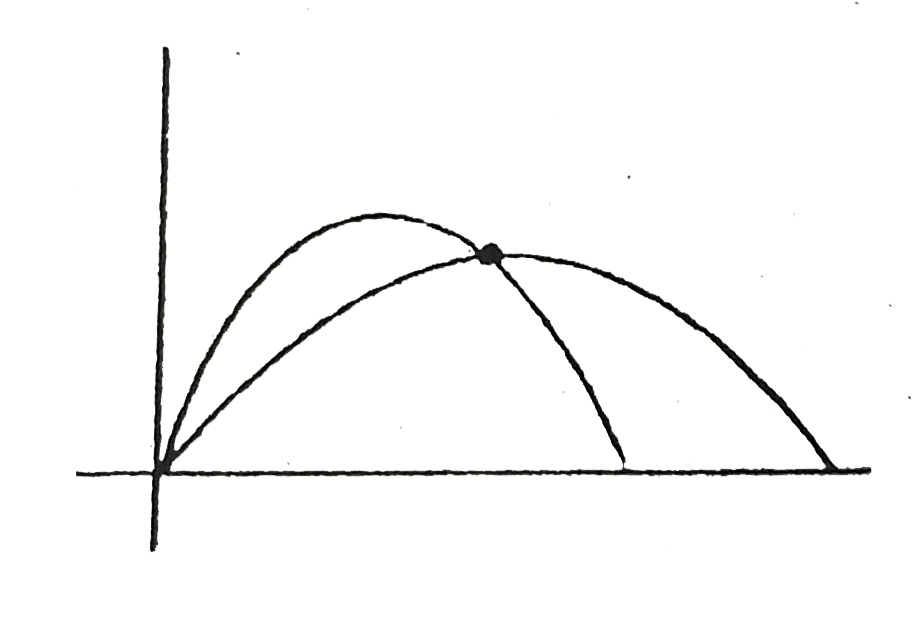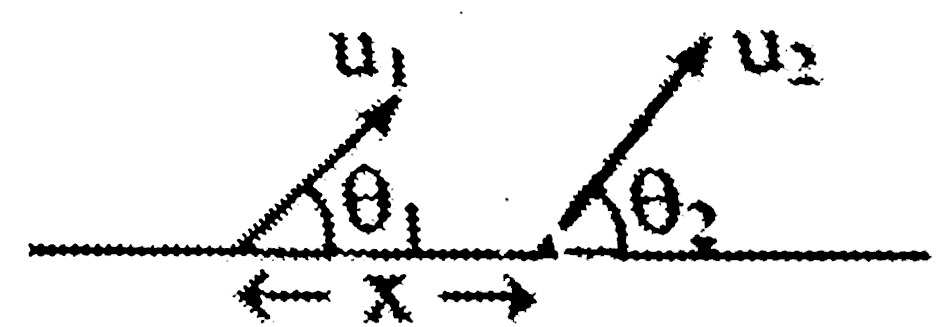Statement-1: Two stones were projected simultaneously from same point with same speed at different angles from horizontal as shown. They may collide at the point of intersection of their paths.

Statement-2: For two particles to collide they must be at the same point in space simultaneously.
Statement -1 is true, statement-2 is true and statement-2 is correct explanation for statement-1.
Statement -1 is true, statement-2 is true and statement-2 is NOT the correct explanation for statement -1.
Statement -1 is true, statement-2 is false.
Statement-1 is false, statement-2 is true.
The correct Answer is:D
ux1=ux2
uy1t−12gt2=uy2
⇒uy1=uy2
Topper's Solved these Questions
- MASTER PRACTICE PROBLEMBOOK - BANSALCHAPTER - MASTER PRACTICE PROBLEMEXERCISE - Multiple objective
131 Videos
- MASTER PRACTICE PROBLEMBOOK - BANSALCHAPTER - MASTER PRACTICE PROBLEMEXERCISE - Subjective
107 Videos
- MASTER PRACTICE PROBLEMBOOK - BANSALCHAPTER - MASTER PRACTICE PROBLEMEXERCISE - Comphrehension
134 Videos
- FLUID MECHANICSBOOK - BANSALCHAPTER - FLUID MECHANICSEXERCISE - PYQS AIEEE
10 Videos
- SEMICONDUCTORSBOOK - BANSALCHAPTER - SEMICONDUCTORSEXERCISE - CBSE Question
32 Videos
Similar Questions
Statement -1 : Two projectiles are launched from the top of a cliff with same initial speed with different angles of projection. They reach the ground with the same speed. Statement -2 : The work done by gravity is same in both the case
View SolutionTwo particles are projected simultaneously from a point with different speeds and along the different directions. When both the particles are in air, then
what will be the path of one particle with respect to the other ?
View Solution
Knowledge Check
Assertion:- Two stones are simultaneously projected from level ground from same point with same speeds but different angles with horizontal Both stones move in same vertical plane. Then the two stones may collide in mid air.
Reason:- For two stones projected simultaneously from same point with same speed at different angles with horizontal, their trajectories must intersect at some point except projection point.AIf both Assertion & Reason are True & the Reason is a correct explanation of the Assertion.BIf both Assertion & Reason are True but Reason is not a correct explanation of the Assertion.CIf Assertion is True but the Reason is False.DIf both Assertion & Reason are False.Two particles are projected from the same point with the same speed at different angles θ1 & θ2 to the horizontal. They have the same range. Their times of flight are t1 & t2 respectily
At1t2=tan2θ1Bt1sinθ1=t2cosθ2Ct1t2=tanθ1Dt1t2=tan2θ2Two bullets are fired simultaneously, horizontally but with different speeds from the same horizontal plane. Which bullet will hit the ground first ?
Athe faster oneBthe slower oneCboth will reach simultaneouslyDdepends on the masses
Two particles are projected simultaneously from the level ground as shown figure. They may collide after a time :

View SolutionTwo particles are projected simultaneously with same speed V0 in same vertical plane at angle 30∘and60∘ With the horizontal .The time at which their velocities becomes parallel is
View SolutionTwo particles are projected with speed 4m/s and 3m/s simultaneously from same point as shown in the figure. Then:

View SolutionTwo particles are projected with speed 4m/s and 3m/s simultaneously from same point as shown in the figure. Then :

View SolutionTwo stones are projected simultaneously from a tower a differenct angles of projection with same speed 'u'. The distance between two stones is increasing at constant rate 'u'. Then the angle between the initial velocity vectors of the two stones is :
View Solution